









Finches In The Ferns
North America Range
General Description
The House Finch is closely
related to the Cassin's Finch
and the Purple Finch, and in
fact, there are places in
Washington where all three
species can be found. All three
species are streaked, and the
males of all three have red
plumage. The House Finch, the
most common and widespread
of the three, typically has a red
head, breast, and rump, but
does not have red coloring on
its brown back or wings. This
helps to differentiate it from the
other two. Female House
Finches have blurrier streaks
and grayer undersides than the
other two species. The breast
streaks do not converge in a
central spot as on many
sparrows. They lack clear white
stripes on their heads. House
Finches have longer tails and
appear more slender overall,
and also have slightly curved
bills, in contrast to the straight
bills found in the other two
species. Like most finches, they
have notched tails. There is
considerable color variation
among males, from pale yellow,
to orange with bright red, this
being the most common. Many
but not all males reach mature
plumage in their first year. The
variation in color is related to
diet.
Habitat
House Finches are native to
open and desert habitats, but
have expanded their range,
naturally and through
introductions, and now can be
found in almost any kind of
human-altered habitat. They
prefer edge habitat and are
absent from dense coniferous
forests.
Behavior
Flocks of House Finches are
common at bird feeders during
the non-breeding season. Some
flocks may stay together through
the breeding season as well,
and birds will use bird feeders
year round. They often forage
on the ground, but also perch
on weeds, shrubs, or trees. Both
males and females may sing
during the breeding season, and
males sing year round.
Diet
The vast majority of the House
Finch's diet is vegetable
matter--seeds, buds, berries,
and nectar. They feed their
young regurgitated seeds. They
eat a few small insects,
especially aphids, but are
primarily seed- and fruit-eaters
at all times of the year.
Nesting
House Finches are
monogamous, and pairs tend to
form while the birds are in their
winter flocks. Some pairs may
stay together year round. They
choose a wide variety of nesting
sites, and will nest in man-made
objects such as window ledges
and holes in buildings. Ivy
growing on buildings or trees
creates many nesting sites.
Nests may also be located in
conifer trees, hanging planters,
and old nests of other birds. The
first requirement is a solid base
with some overhanging material.
The female builds most of the
nest, which is an open cup of
grass, weeds, twigs, leaves, and
rootlets, lined with feathers and
other fine material. The female
incubates 4 to 5 eggs for 13 to
14 days while the male brings
her food. The female broods the
young for the first few days after
they hatch, and the male
continues to bring food. The
female then joins the male in
bringing food to the young. The
young leave the nest after 12 to
15 days and may be fed by the
male for about two more weeks,
while the female starts a second
clutch. Pairs may raise three or
more broods each season.
Migration Status
Throughout their range, many
House Finch populations
migrate, either short distances
latitudinally or altitudinally.
Before 1945, populations of
House Finches in the Okanogan
Valley migrated south, but since
1945, House Finches in this
area have been resident.
Conservation Status
House Finches are native to the
southwestern United States and
Mexico, but through natural and
artificial range expansion, they
are now abundant throughout
North America. House Finches
first expanded into the Columbia
Basin from points south in 1885.
They were introduced in the
eastern United States when
illegal caged birds were
released in New York in 1940.
Facilitated by dam construction
and the conversion of steppe
habitat to irrigated agriculture,
they slowly expanded their
range in Washington through
the early 20th Century. They
first arrived in western
Washington in the 1950s, and
are now common throughout the
state, with significant yearly
increases recorded by the
Breeding Bird Survey since
1966. In human-altered settings,
this finch outcompetes its close
relatives, the Cassin's Finch and
the Purple Finch. Its presence
has been considered to be a
major cause of the Purple
Finch's decline in western
Washington.
Source: www.birdweb.org
General Description
The House Finch is closely
related to the Cassin's Finch
and the Purple Finch, and in
fact, there are places in
Washington where all three
species can be found. All three
species are streaked, and the
males of all three have red
plumage. The House Finch, the
most common and widespread
of the three, typically has a red
head, breast, and rump, but
does not have red coloring on
its brown back or wings. This
helps to differentiate it from the
other two. Female House
Finches have blurrier streaks
and grayer undersides than the
other two species. The breast
streaks do not converge in a
central spot as on many
sparrows. They lack clear white
stripes on their heads. House
Finches have longer tails and
appear more slender overall,
and also have slightly curved
bills, in contrast to the straight
bills found in the other two
species. Like most finches, they
have notched tails. There is
considerable color variation
among males, from pale yellow,
to orange with bright red, this
being the most common. Many
but not all males reach mature
plumage in their first year. The
variation in color is related to
diet.
Habitat
House Finches are native to
open and desert habitats, but
have expanded their range,
naturally and through
introductions, and now can be
found in almost any kind of
human-altered habitat. They
prefer edge habitat and are
absent from dense coniferous
forests.
Behavior
Flocks of House Finches are
common at bird feeders during
the non-breeding season. Some
flocks may stay together through
the breeding season as well,
and birds will use bird feeders
year round. They often forage
on the ground, but also perch
on weeds, shrubs, or trees. Both
males and females may sing
during the breeding season, and
males sing year round.
Diet
The vast majority of the House
Finch's diet is vegetable
matter--seeds, buds, berries,
and nectar. They feed their
young regurgitated seeds. They
eat a few small insects,
especially aphids, but are
primarily seed- and fruit-eaters
at all times of the year.
Nesting
House Finches are
monogamous, and pairs tend to
form while the birds are in their
winter flocks. Some pairs may
stay together year round. They
choose a wide variety of nesting
sites, and will nest in man-made
objects such as window ledges
and holes in buildings. Ivy
growing on buildings or trees
creates many nesting sites.
Nests may also be located in
conifer trees, hanging planters,
and old nests of other birds. The
first requirement is a solid base
with some overhanging material.
The female builds most of the
nest, which is an open cup of
grass, weeds, twigs, leaves, and
rootlets, lined with feathers and
other fine material. The female
incubates 4 to 5 eggs for 13 to
14 days while the male brings
her food. The female broods the
young for the first few days after
they hatch, and the male
continues to bring food. The
female then joins the male in
bringing food to the young. The
young leave the nest after 12 to
15 days and may be fed by the
male for about two more weeks,
while the female starts a second
clutch. Pairs may raise three or
more broods each season.
Migration Status
Throughout their range, many
House Finch populations
migrate, either short distances
latitudinally or altitudinally.
Before 1945, populations of
House Finches in the Okanogan
Valley migrated south, but since
1945, House Finches in this
area have been resident.
Conservation Status
House Finches are native to the
southwestern United States and
Mexico, but through natural and
artificial range expansion, they
are now abundant throughout
North America. House Finches
first expanded into the Columbia
Basin from points south in 1885.
They were introduced in the
eastern United States when
illegal caged birds were
released in New York in 1940.
Facilitated by dam construction
and the conversion of steppe
habitat to irrigated agriculture,
they slowly expanded their
range in Washington through
the early 20th Century. They
first arrived in western
Washington in the 1950s, and
are now common throughout the
state, with significant yearly
increases recorded by the
Breeding Bird Survey since
1966. In human-altered settings,
this finch outcompetes its close
relatives, the Cassin's Finch and
the Purple Finch. Its presence
has been considered to be a
major cause of the Purple
Finch's decline in western
Washington.
Source: www.birdweb.org
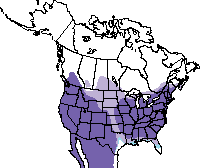
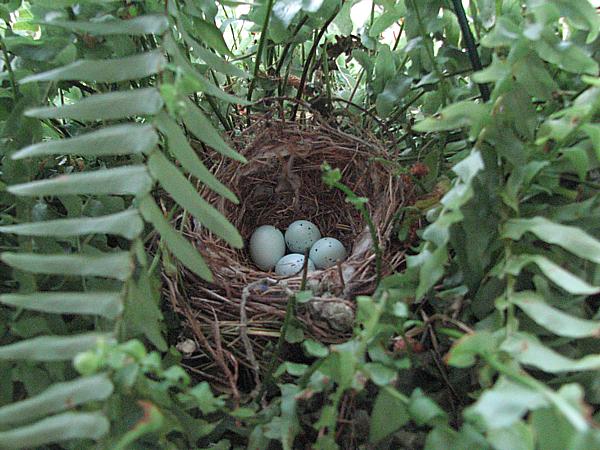
May 01, 2009: Very first look at the eggs
A few days ago I stepped out onto my front porch to retrieve the mail when I noticed a bird fly from a hanging fern plant. After closer observation, I found a nest with 4 small bluish eggs neatly concealed among the long leaves. I watched for a while and when the owner of the eggs returned, I saw that we had a Finch as a temporary house guest.
The purpose of this page is to document through photos and videos the hatching and raising of the babies as I did with the Robin Project last spring. Please check back for updates.
The purpose of this page is to document through photos and videos the hatching and raising of the babies as I did with the Robin Project last spring. Please check back for updates.
May 05, 2009: A short video of the female Finch returning to the nest.
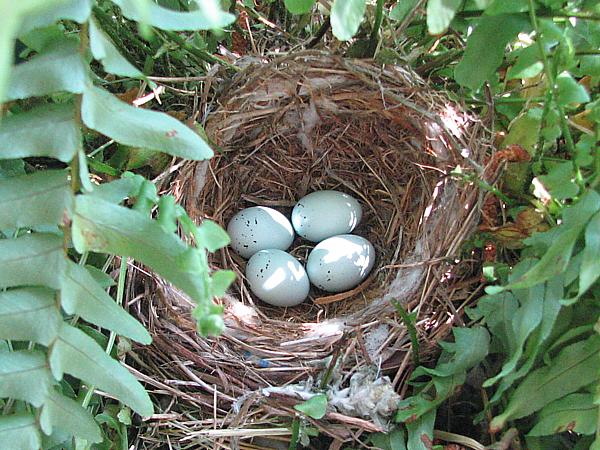
May 06, 2009
May 08, 2009: One of the eggs hatched this morning
May 08, 2009: Later on today another finch hatched out
May 09, 2009: There is a grand total of three babies now.
They are actually beginning to resemble birds.
They are actually beginning to resemble birds.
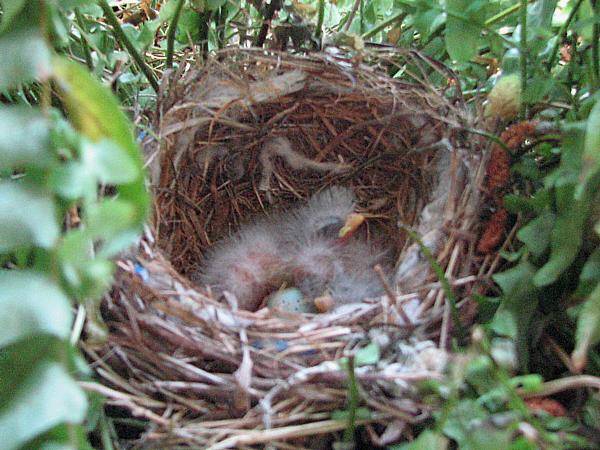
May 13, 2009: The babies are getting a little fuzzier now.
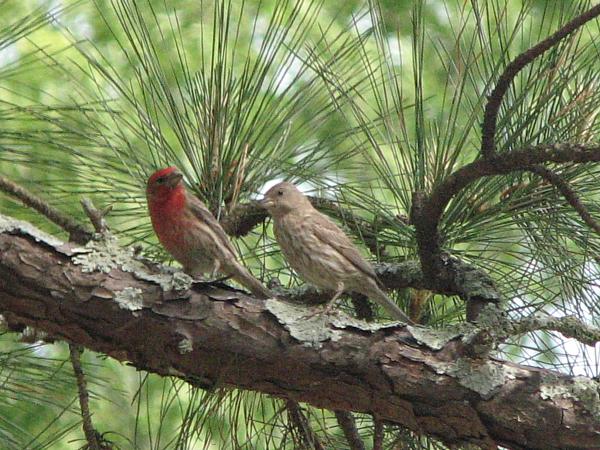
Momma and Pappa Finch keeping a watchful eye on the nest.
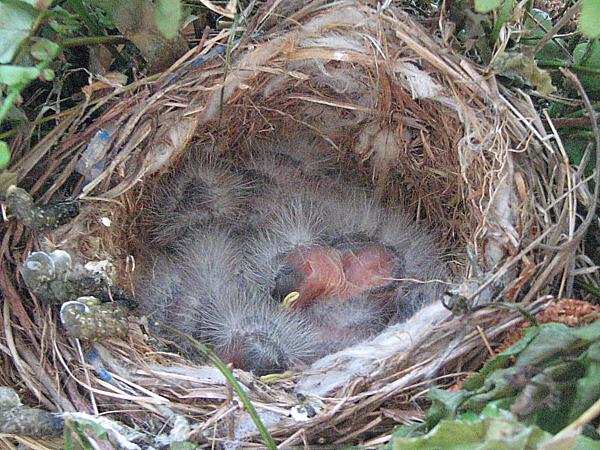
May 15, 2009
May 16, 2009: Male and female Finch feeding their young.


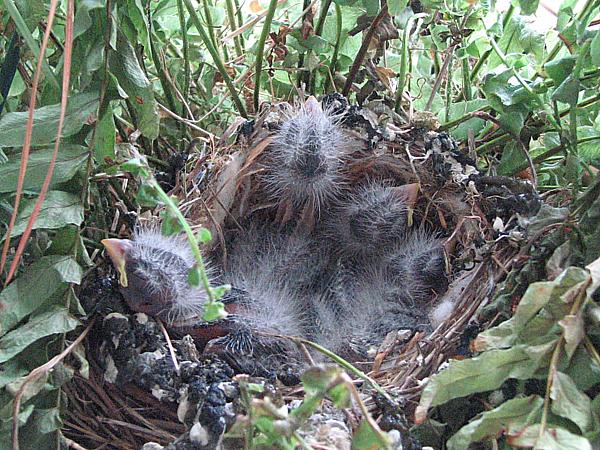
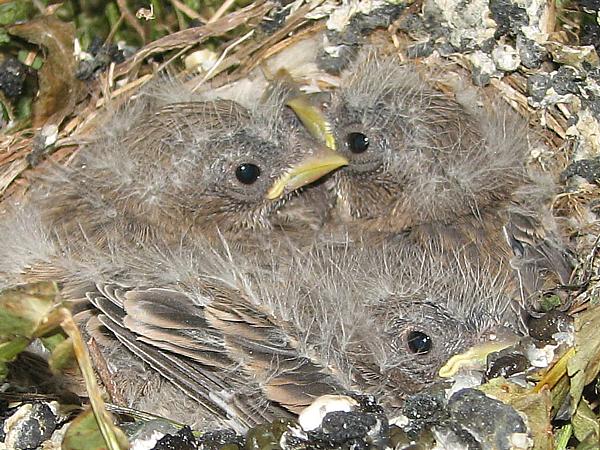
May 20, 2009
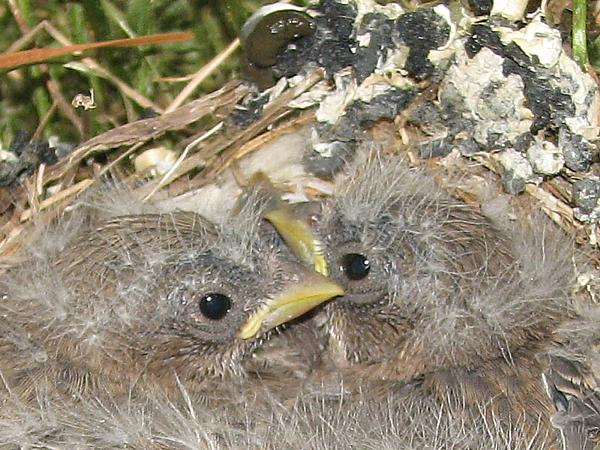
May 22, 2009: The young are beginning to resemble the adults more and more every day.

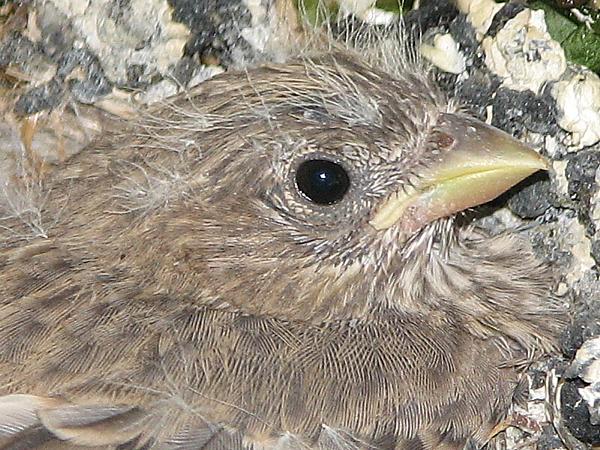
May 24, 2009: I noticed this afternoon that the adults were not hanging around
the nest as much.
the nest as much.


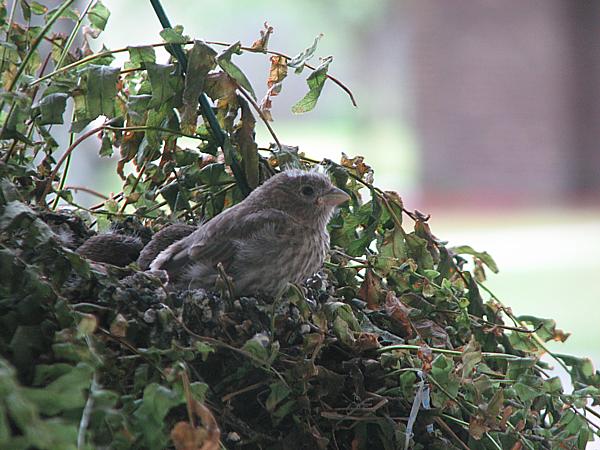
May 24, 2009: Later on today I noticed one particular finch standing on the edge of the nest exercising his wings.
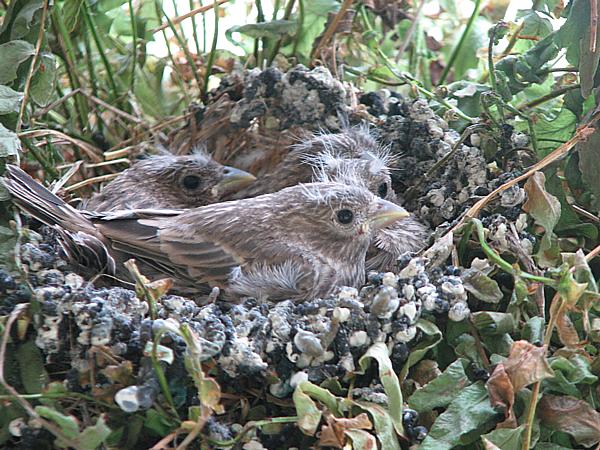
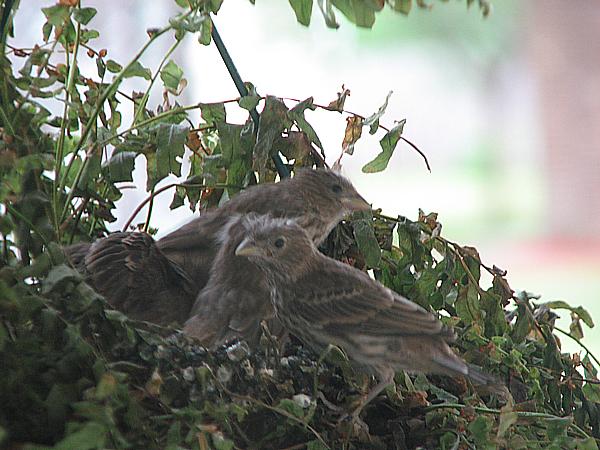
May 24, 2009: One last look. I stepped to front door late this evening and all of the young were jumping around the nest. Some of them would actually climb up on the fern plant and flap their wings. I figured it was just a matter of
time before they would be leaving the nest for good.
May 25, 2009: Woke up this morning to an empty nest. Once again the cycle of life continues. Maybe next year one of these young will raise a family nearby.
time before they would be leaving the nest for good.
May 25, 2009: Woke up this morning to an empty nest. Once again the cycle of life continues. Maybe next year one of these young will raise a family nearby.